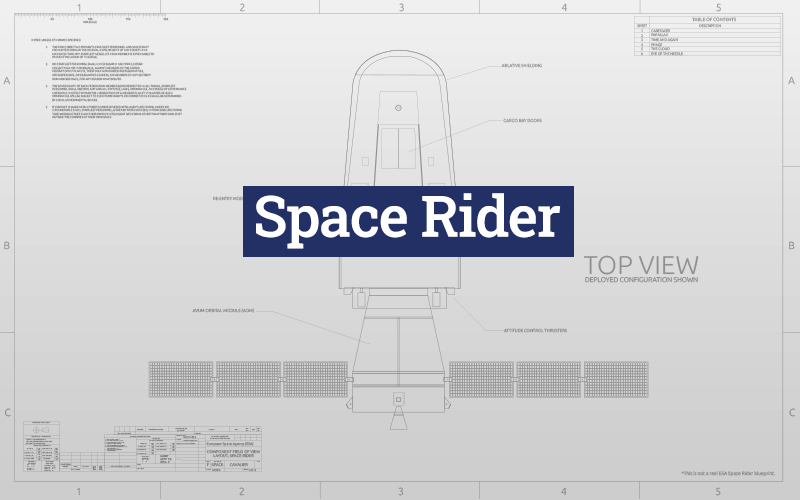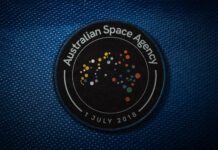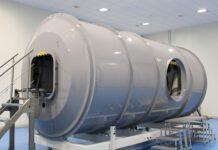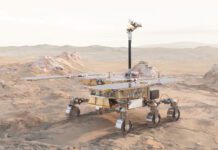
At its most basic, ESA’s Space Rider spacecraft is an uncrewed robotic laboratory in orbit that is the size of around two minivans. It has the capacity to remain in orbit for approximately two months before returning to Earth touching down on a runway under a parafoil to be unloaded, refurbished, and launched on another mission.
As we move towards a post-International-Space-Station era, this independent multipurpose laboratory in low Earth orbit could become an attractive option for affordable in-orbit experimentation for both a European and global customer base.
The maiden flight of ESA’s reusable Space Rider spacecraft is slated for the fourth quarter of 2023 aboard a Vega-C rocket from the Guiana Space Centre in French Guiana. This flight will be managed and operated by ESA. Following that maiden flight, however, the reigns for the program will be handed to a currently unselected commercial operator.
Speaking to European Spaceflight, acting ESA Space Rider Programme Manager Dante Galli shed light on where the Space Rider initiative is today and what its future looks like.
2023 ESA Space Rider update from programme manager Dante Galli.
Where is the ESA Space Rider project at the moment?
The Project is currently in the final part of the bridging phase (the phase dealing with industrial reorganization after the ESA Ministerial Council in 2019), closing the remaining subsystem detailed design phase. The Critical Design Review at System level is expected to be held and closed by Mid-2022, paving the way for entering into the implementation, test, and validation phase.
How many Space Rider vehicles do ESA plan to build?
The Space Rider Re-entry Module (RM) was conceived to be reused for six flights, this will validate one of the key objectives of the programme which is reusability. These first six flights shall also enable industry to approach a commercial phase of the project, where the project should become commercially self-sustainable. Therefore, ESA plans to build the first vehicle and to sustain the growth of the project through the first six flights. At the same time, ESA is planning improvements of the current vehicle baseline, in terms of performances and services. These improvements will likely be implemented in the first flight model (for in-flight demonstration in one of the first model re-fligths) or in a subsequent flight model.
How many Space Rider vehicles will likely be in service at any one time?
This depends on the market needs. There would be no technical showstopper to have several Space Riders operating.
Has there been significant interest from industry in being a part of the maiden flight? And have customers been booked for subsequent flights?
There was indeed. 40 potential customers have been identified through the latest Announcement for Opportunities issued late 2021 in addition to the ones already identified. Those payloads are too many for a single flight. As a result, they will be grouped in mission aggregates that will be flown over several flights. The aggregate for the first flight is expected to be frozen by the end of 2022.
Are there any discussion about an upgrade from Space Rider?
Of course, there are discussions running for the future of Space Rider in preparation of the coming ESA Ministerial Council CM22, concerning both the Orbital Module and the Re-Entry Module. At the time being. any detailed information cannot be disclosed.
In addition to answering our questions regarding the future of the Space Rider programme, Galli and his team also supplied European Spaceflight with a set of detailed technical specifications for the vehicle as they stand today.
ESA Space Rider technical specifications
Space Rider Basics
Space Rider Basics
Participating states: France, Ireland, Italy, Portugal, Romania, Spain, Switzerland, Belgium, Czech Republic, Norway
Operator: ESA (for the Maiden flight only) the operator for subsequent flights will be selected in 2022
Prime Contractors: AVIO, Thales Alenia Space Italy for Flight Segment, ALTEC and Telespazio for Ground Segment
Launch vehicle: Vega-C
Planned debut: Q4/2023
Launch site: Europe’s Spaceport, French Guiana
Landing site(s): Europe’s Spaceport, French Guiana as baseline, Portugal and Italy as alternatives for mid-inclination missions
Total length: 8.044 m (Full stack AOM + RM)
Launch mass (includes service module): ~ 4900 kg (Full stack AOM + RM, including fluids and propellants)
Flight time: At least 60 days
Space Rider Payload Capacity
Volume: 1,200l/1.2 m3
Mass: 620 kg
Power: 600W
Landing: <4g reentry + subsonic parachute + soft landing under a parafoil
Notable features:
- Reusability of the Re-entry module with limited refurbishment for recurring access to LEO
- Openable cargo bay with field of view to Earth or deep space
- Fine pointing capability
- High quality micro-g (10-6 g)
- Late access payload installation before launch up to 26h before launch
- Early access starting at 3h after landing
- Reduced safety constraints compared to crewed platforms
Space Rider Re-entry Module
Derived from IXV experimental spaceplane vehicle, integrating a Multi-Purpose Cargo Bay for payload accommodation
Launch mass: up to 2950kg
Landing mass: up to 2850kg
Length: 4.6m
Diameter: 2.3m max
Number of missions: At least 6
Turnaround time: Under 6 months
Space Rider Service module – AVUM Orbital Module (AOM)
Derived from Vega-C + upper stage (AVUM+) with the addition of ALEK (Avum Life Extension Kit). The SR-AOM is able to supply power, perform manoeuvres and provide in-orbit attitude control until separation from Re-entry Module.
Diameter: 2.3m max (Solar arrays in folded configuration)
Length: 3.5m (including MEA protuberance)
Launch mass: 2000 kg (ALEK + AVUM)
Engine: AVUM+ Main Engine (MEA)
Average thrust: 2.4kN
Specific impulse: 316s
Cumulated firing time: 940 seconds







